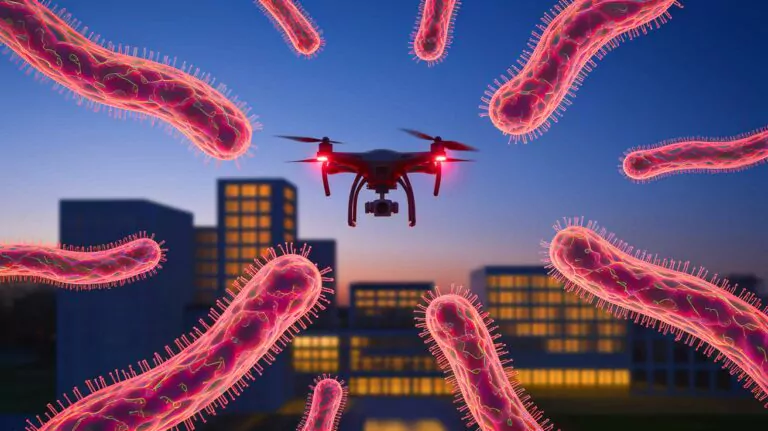| IN A NUTSHELL |
|
In an exciting development at the intersection of biology and technology, researchers have genetically engineered bacteria to emit light in both visible and infrared ranges. This breakthrough allows these modified organisms to communicate chemical signals over long distances, effectively turning them into living sensors. These signals can be detected by drones or satellites equipped with hyperspectral cameras, paving the way for innovative applications in agriculture, environmental monitoring, and more. This article delves into the science behind this advancement, its potential uses, and the implications for various sectors.
Breaking New Ground in Bacterial Communication
Traditionally, engineered bacteria have been used as sensors to monitor pollutants or nutrients in environments like soil. However, their practical application outside the laboratory has been limited due to the need for close-range, specialized imaging equipment to detect their fluorescent signals. MIT researchers have now overcome this barrier by developing bacteria that emit unique optical signatures when exposed to specific molecules. These signatures can be detected from distances up to 295 feet using hyperspectral cameras, dramatically increasing the range and utility of bacterial sensors.
The innovation lies in the ability to modify bacteria to emit light that falls under both visible and infrared spectrums. When these genetically engineered bacteria encounter certain chemicals, they produce light-emitting molecules known as hyperspectral reporters. This allows the emitted light to be captured by cameras from a significant distance, transforming how we obtain information from biological systems. According to Christopher Voigt, a senior author of the study, this technology provides a new way to extract information from cells without the need for direct visual observation.
“Racing Past Rivals”: New US Hypersonic Testbed Contract Surges Ahead of Russia, China
From Lab to Field: Sensing Bacteria in Action
The transition from laboratory to field tests has showcased the potential of these modified bacteria in real-world settings. Researchers placed the bacteria in secure boxes and deployed them in various locations, including rooftops and desert plots. Drones equipped with hyperspectral cameras scanned these areas, capturing data on which bacteria had activated their reporter molecules. This rapid scanning process, taking less than 30 seconds per field, demonstrates the efficiency and practicality of the system.
Notably, the technology has already been tested to detect specific elements such as arsenic. Its flexibility allows it to be adapted for various uses, from precision agriculture—monitoring soil nutrient levels like nitrogen—to environmental safety applications, including landmine detection. The possibility of engineering bacteria to work inside plant cells opens up further avenues for creating living systems that communicate through light signals visible from the sky. As Yonatan Chemla, one of the lead authors of the paper, explains, the ongoing work involves understanding regulatory landscapes, safety concerns, and the benefits of this groundbreaking technology.
The Science Behind Hyperspectral Reporters
The core of this technological leap is the genetic engineering of bacteria to emit light through hyperspectral reporters. These light-emitting molecules have been genetically linked to sensor circuits within the bacterial cells. Researchers, using quantum calculations, examined around 20,000 natural cell compounds to identify those with the most unique spectral fingerprints. Two primary selections emerged: biliverdin, a pigment derived from heme breakdown and bacteriochlorophyll, a photosynthetic pigment found in certain bacteria.
The significance of these compounds is that they are distinct from other molecules and require minimal enzymes for production within the cell. This makes them ideal candidates for creating detectable signals. The versatility of these reporters means they can be added to any bacterium with a genetically encoded sensor, enabling it to respond to various environmental triggers such as metals, radiation, or toxins. As Voigt puts it, these reporters provide a means to remotely sense biological responses, greatly expanding the capabilities of bacterial sensors.
“Unseen heroes in a petri dish”: these new viruses massively combat climate change now
Potential Applications and Future Prospects
The applications of this technology are vast and varied. In agriculture, it can revolutionize how farmers monitor soil health, optimizing the use of fertilizers and reducing environmental impact. In environmental contexts, it offers a novel approach to detecting contaminants or hazardous substances. The adaptability of the system also hints at potential uses in other fields, such as medical diagnostics or industrial monitoring. However, the introduction of such technology also raises questions about regulatory frameworks and safety protocols.
With the ability to integrate these sensors into living systems, the scope of what can be achieved is only limited by imagination and ethical considerations. As the technology progresses, it will be essential to address concerns about genetic modifications and their implications. Balancing innovation with caution will be key to harnessing the full potential of these remarkable biosensors.
As we stand on the cusp of a new era in biosensing technology, the possibilities seem boundless. From enhancing agricultural efficiency to safeguarding the environment, the impact of these glowing bacteria could be profound. What other unexpected applications might emerge as we continue to explore this fascinating intersection of biology and technology?
Did you like it? 4.6/5 (20)








Wow, this sounds like something out of a sci-fi movie! How soon could this tech be used in everyday life? 🚀
That strange fog that’s hurting people. Wonder if it’s related.
Are there any safety concerns with releasing genetically modified bacteria into the environment?
I’m a bit skeptical about the practical applications. What about the cost of implementing such systems on a large scale?
Finally, a use for glowing bacteria that isn’t just for show! Awesome work, MIT! 🌟
How do they ensure these bacteria only emit light when needed and not randomly?
Is Russia actually working on similar technology, or are they just calling it science fiction?
Nothing in the article refers to Russia except the title. Scientific articles should not use click bait titles, but it’s interesting how effective it was.
What about integrating these sensors into human cells? Is that a possibility?
This could revolutionize agriculture! Imagine the precision in monitoring soil nutrients. 🌿
Can these glowing bacteria survive in harsh environments like deserts or frozen areas?
I wonder if these bacteria can be programmed to detect other chemicals like methane or carbon dioxide.
Reading this made my day! Science is just amazing. Thank you! 😊
How long before we see commercial drones equipped with this technology flying over our farms?
Sure, it’s cool, but what about the ethical implications? Are we playing God with bacteria? 🤔
We have been playing god with bateriums for a very long long time. This is just the latest thing to be brought out to the open. Stap in and sit back things about to get all wild in here for a bit.
This seems like a game-changer for landmine detection. Cheers to saving lives! 🥂
MIT always pushing the boundaries. What’s next on their agenda?
Can these bacteria be engineered to turn off their light-emitting properties once the chemical detection is complete?
How do they ensure these drones are accurate in data collection, especially in windy conditions?
What other universities or research centers are working on similar technologies?
Are there any plans to test this technology in urban environments?
Love the potential applications, but how feasible is it to scale up this technology? 🤔
Will this technology be affordable for small-scale farmers, or is it only for big corporations?
Why does Russia call it science fiction? Do they doubt the technology or its implications?
This could open up so many new research avenues! Exciting times ahead for science! 🌟
Great. All we need now is an 20th generation of genetically modified bacteria , which must be sprinkled all over soil ,in order to fulfill its function. Has anyone thought of eventual sideeffects when these get into the body of a human????
This is sick.
Inventing things just for the sake of inventing is even more sick.
How reliable are these hyperspectral cameras for detecting bacterial signals from such distances?
Science fiction becoming reality! What’s next? Bacteria sending text messages? 😂
Could this technology be used for detecting water pollution as well?
Where in this article do you talk about Russia? I don’t understand the headline. Or is that just clickbait.